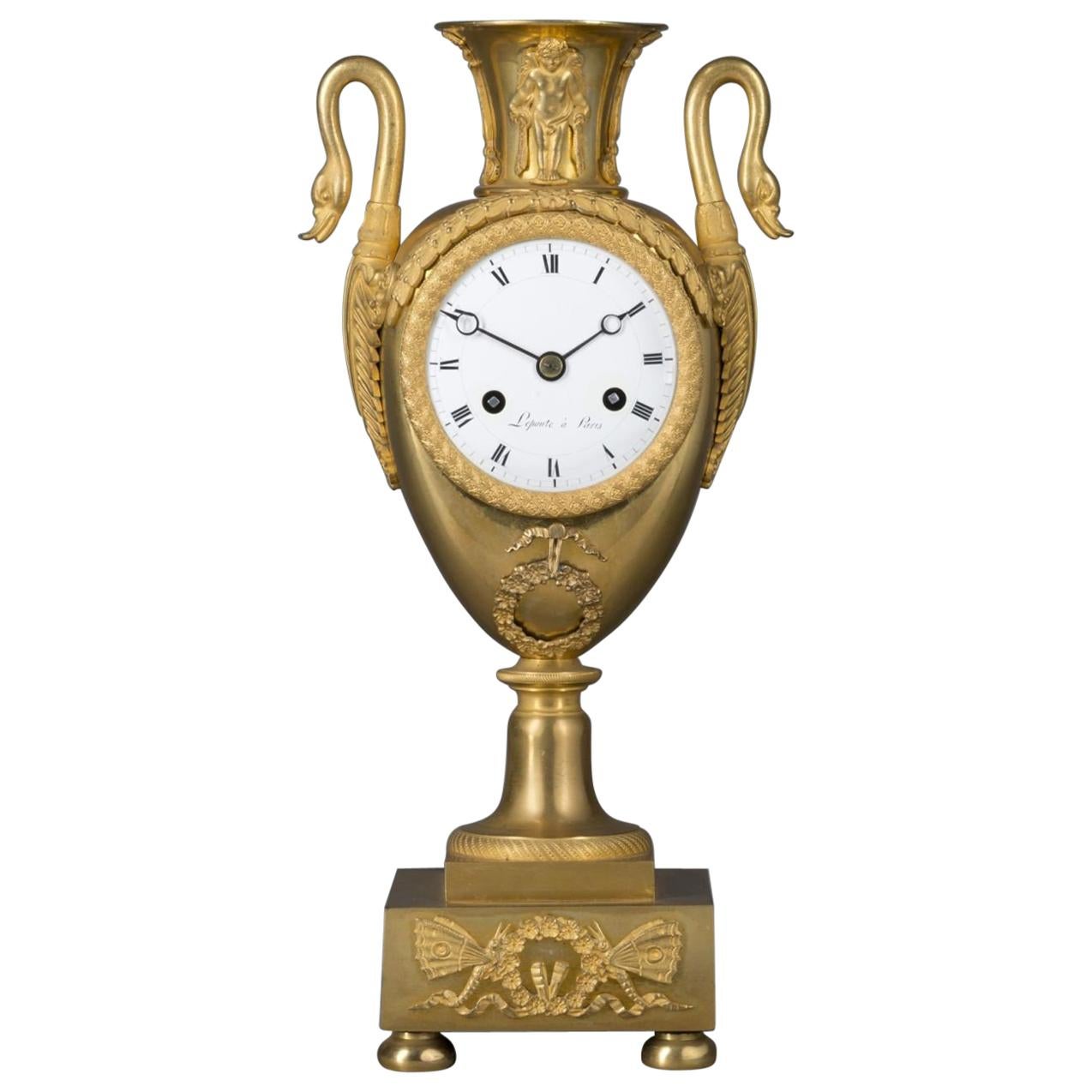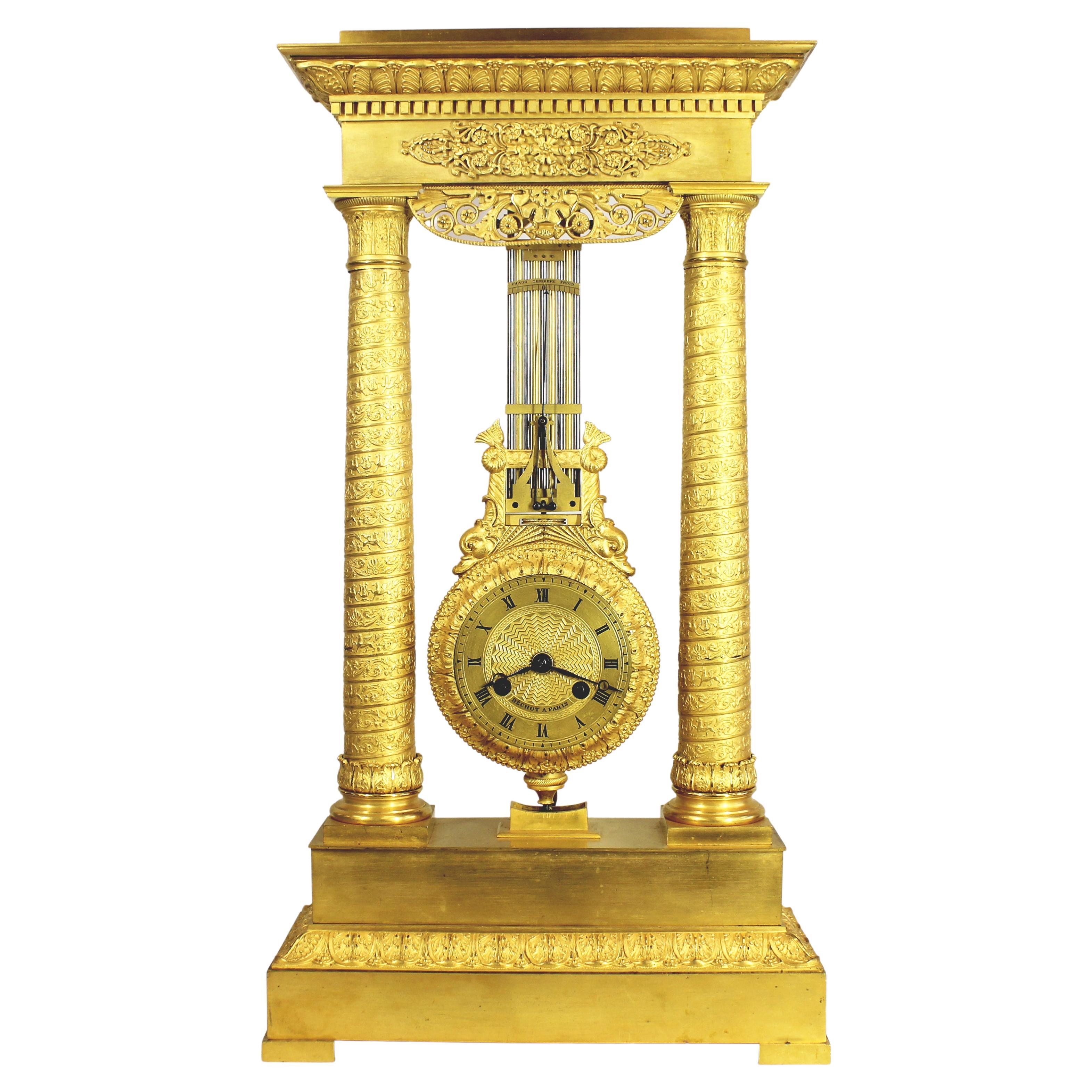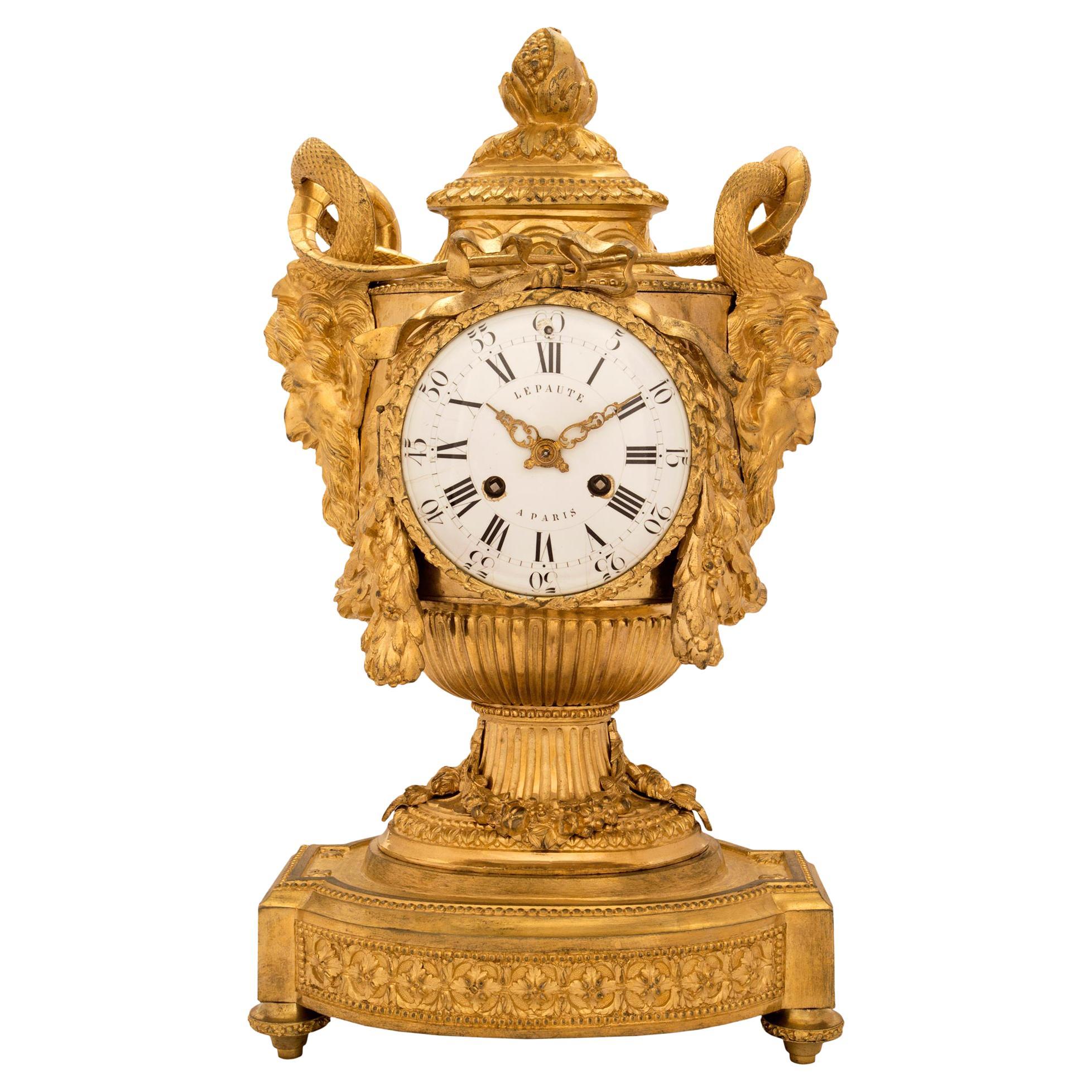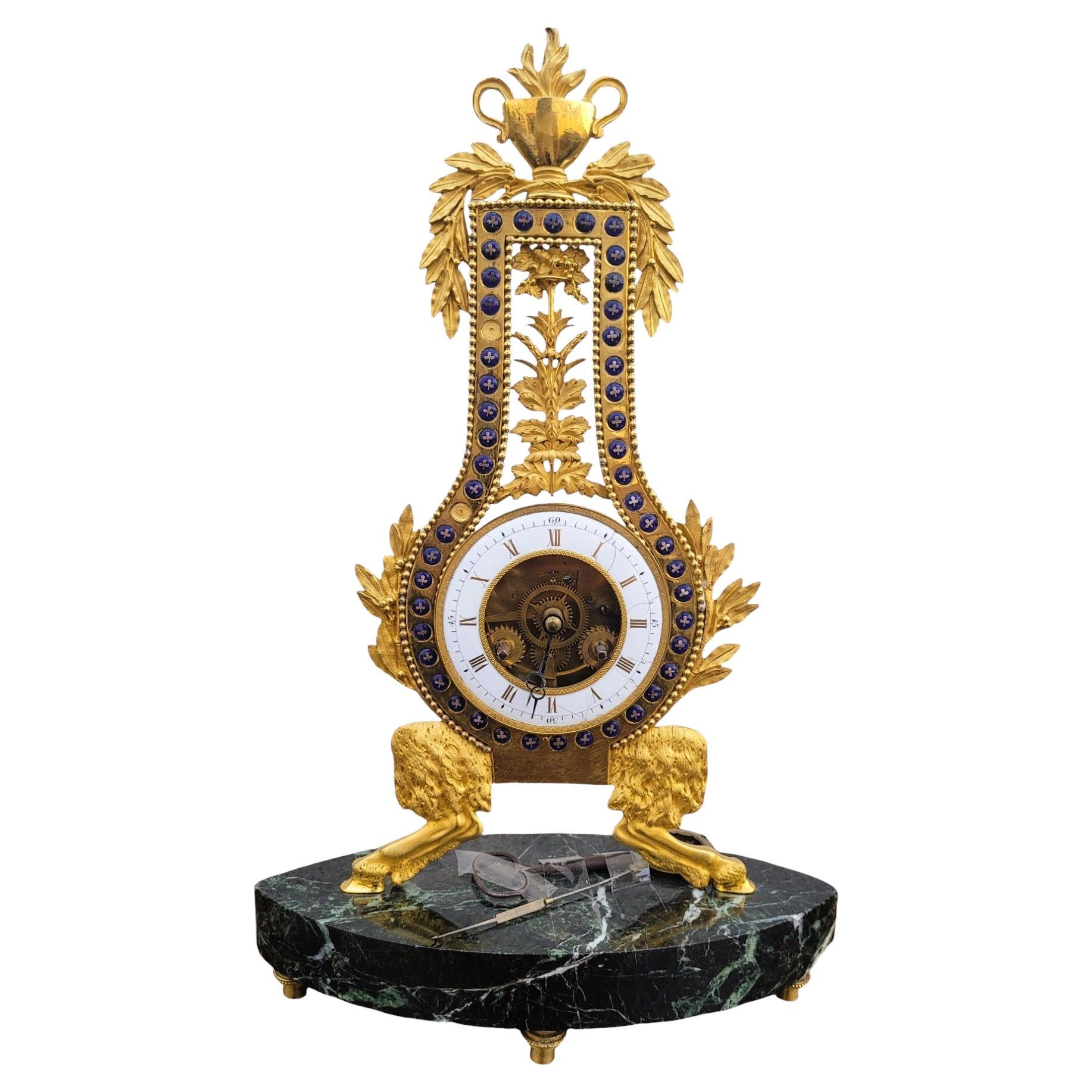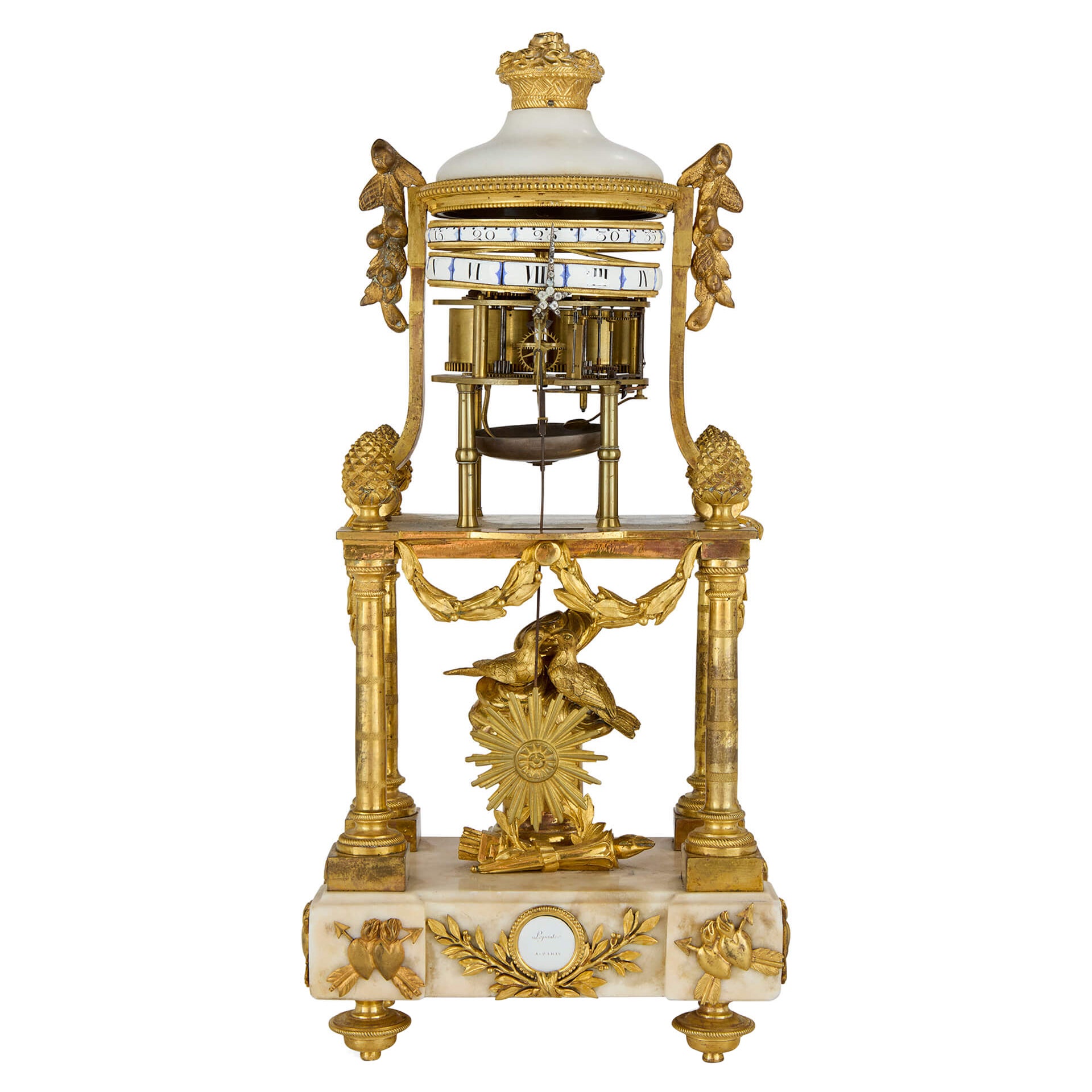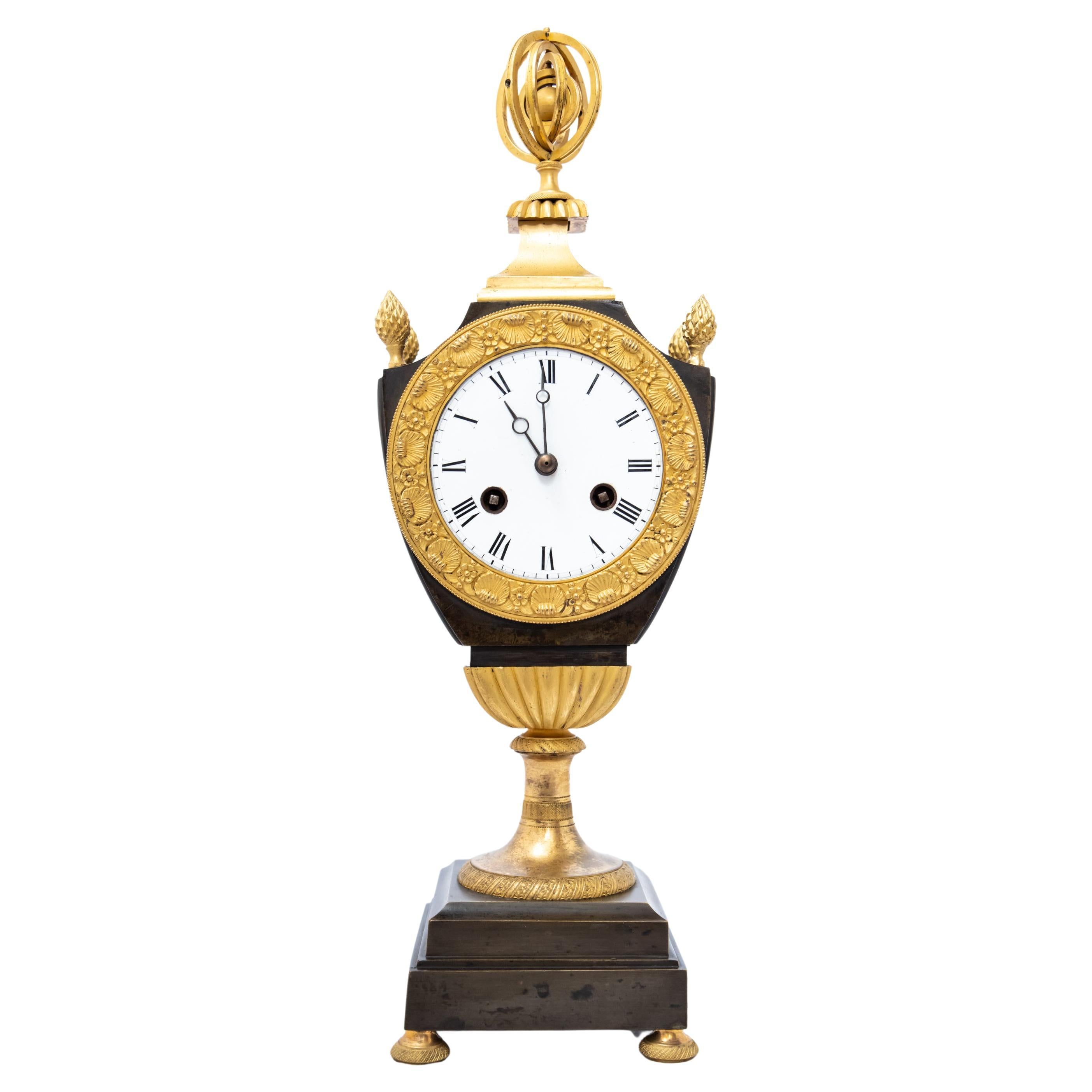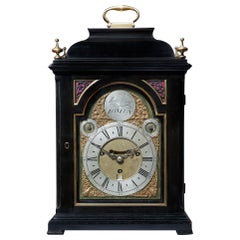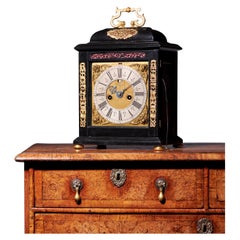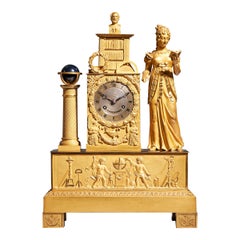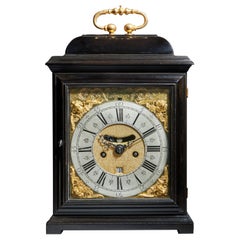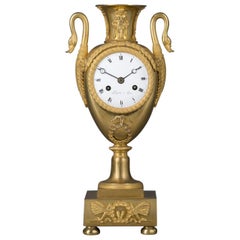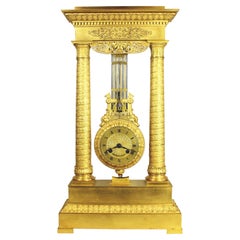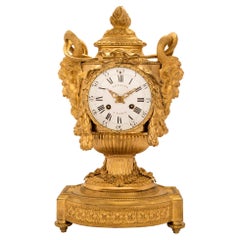Items Similar to A Unique 18th Century Georgian Urn Clock by Paul Rimbault, Soho London, 1770
Want more images or videos?
Request additional images or videos from the seller
1 of 11
A Unique 18th Century Georgian Urn Clock by Paul Rimbault, Soho London, 1770
$47,920.20
£34,900
€40,774.63
CA$66,542.71
A$72,613.53
CHF 38,087.02
MX$881,915.51
NOK 475,727.79
SEK 449,586.55
DKK 304,326.43
About the Item
A unique and exceptional neoclassical urn clock by Paul Rimbault, London, circa 1770. This singular example of a pendule à cercles tournants stands as a masterpiece of English clockmaking and design from the Georgian period.
The ormolu case is of remarkable quality, with a richly ornamented square plinth base containing the movement, surmounted by an elegant lidded urn with bold scrolled handles terminating in anthemion motifs. Ram’s heads frame either side of the urn and are echoed in the decorative corners of the base. The classical design, inspired by the work of the celebrated architect and designer Robert Adam, is further embellished with finely cast drapery swags, foliate details, and classical medallions. While there is no direct connection between Rimbault and Adam, this clock reflects the influence of Adam’s neoclassical style, which shaped the decorative arts in Britain during the period and inspired clockmakers, bronze casters, and artisans alike. The urn is crowned with an exquisitely cast eagle finial, a further nod to classical symbolism.
The time is displayed through two silvered brass rotating rings set into the body of the urn: the lower ring showing Roman numerals for the hours, the upper ring marked in Arabic numerals for every five minutes, with additional minute divisions. A delicate blued steel pointer indicates the time. The winding holes are cleverly concealed by a sliding shutter adorned with martial motifs, echoed by the ornament on the rear door.
The eight-day double chain fusee movement, mounted between rectangular plates, features an anchor escapement with a short pendulum and stirrup regulation. The strike train chimes the hour and the half-hour on a single bell, with repeat striking on demand via a pull cord. The strike can be silenced through an arbor on the backplate.
This clock is not only a rare survival but a unique piece, combining the finest elements of English craftsmanship, technical ingenuity, and neoclassical design. A true collector’s treasure of museum quality.
Paul Rimbault was a member of a family of clockmakers of Huguenot descent, who excelled in clockmaking. There are some very special clocks known by his hand. He worked from Denmark Street, Soho, from 1770 until his death in 1785. His brother Stephen was also a prolific maker, notably of musical and automaton clocks, with an exceptional example in the Ashmolean Museum in Oxford.
- Creator:Paul Rimbault (Cabinetmaker)
- Dimensions:Height: 19.3 in (49 cm)Width: 4.73 in (12 cm)Depth: 4.73 in (12 cm)
- Style:Adam Style (Of the Period)
- Materials and Techniques:
- Place of Origin:
- Period:
- Date of Manufacture:1770
- Condition:Wear consistent with age and use. Fully restored in perfect working condition for generations to come.
- Seller Location:Oxfordshire, GB
- Reference Number:1stDibs: LU4936244103302
About the Seller
5.0
Recognized Seller
These prestigious sellers are industry leaders and represent the highest echelon for item quality and design.
1stDibs seller since 2019
24 sales on 1stDibs
Typical response time: A week
Associations
LAPADA - The Association of Arts & Antiques Dealers
- ShippingRetrieving quote...Shipping from: Newbury, United Kingdom
- Return Policy
Authenticity Guarantee
In the unlikely event there’s an issue with an item’s authenticity, contact us within 1 year for a full refund. DetailsMoney-Back Guarantee
If your item is not as described, is damaged in transit, or does not arrive, contact us within 7 days for a full refund. Details24-Hour Cancellation
You have a 24-hour grace period in which to reconsider your purchase, with no questions asked.Vetted Professional Sellers
Our world-class sellers must adhere to strict standards for service and quality, maintaining the integrity of our listings.Price-Match Guarantee
If you find that a seller listed the same item for a lower price elsewhere, we’ll match it.Trusted Global Delivery
Our best-in-class carrier network provides specialized shipping options worldwide, including custom delivery.More From This Seller
View AllRare 18th Century George II Musical Table Clock by Matthew King, circa 1735
Located in Oxfordshire, United Kingdom
A rare George II musical table clock by Matthew King, circa 1735.
This unusual eight-day spring-driven table clock was made by Matthew King, wh...
Category
Antique 18th Century English George II Table Clocks and Desk Clocks
Materials
Silver, Brass
A 17th Century William and Mary eight-day table clock by Isaac Lowndes, 1695
Located in Oxfordshire, United Kingdom
A fine William and Mary eight-day spring-driven table clock signed on the backplate, Isaac Lowndes Pallmall Court, c.1695.
The elegantly proportioned ebony-veneered oak domed top c...
Category
Antique 17th Century English William and Mary Table Clocks and Desk Clocks
Materials
Brass
Fine 19th century French ormolu mantel clock (pendule) by Leroy a Paris, c. 1825
By LeRoy
Located in Oxfordshire, United Kingdom
A most beautiful French ornolu mantel clock by Leroy à Paris
A lovely French late Empire/early Charles X mantel clock with an ormolu case, c. 1825. The ormolu brass case depicts a celebration of Science and Learning. It is dominated by a rectangular superstructure containing the movement, flanked by an engine-turned column with a celestial globe on top on the left and an elegant lady reading a book on the right. The superstructure is surmounted by a bookcase and a bust of Socrates...
Category
Antique Early 19th Century French Empire Mantel Clocks
Materials
Brass, Ormolu
A rare 17th century English eight-day spring-driven table clock by J Gerrard
Located in Oxfordshire, United Kingdom
A Rare Late 17th Century English Eight-Day Spring-Driven Table Clock, Circa 1700. England
Signed J. Gerrard.
This exceptional late 17th-century English eight-day table clock is a s...
Category
Antique 17th Century English William and Mary Table Clocks and Desk Clocks
Materials
Brass
A Rare and Important Charles II 17th Century Table Clock by Henry Jones
By Henry Jones
Located in Oxfordshire, United Kingdom
The Rare and Important 17th Century Spring Driven Table Clock by the Celebrated Maker, Henry Jones.
Provenance dating back to 1745. Owned by Captain Alexander Raitt
A very rare an...
Category
Antique 17th Century English Charles II Table Clocks and Desk Clocks
Materials
Brass
17th Century English eight-day spring-driven table clock, by John Wrench
Located in Oxfordshire, United Kingdom
A Rare Late 17th Century English Basket-Top Spring Clock by John Wrench of Chester, Circa 1695-1700. England
This exquisite late 17th-century English basket-top table clock, signed ...
Category
Antique 17th Century English William and Mary Table Clocks and Desk Clocks
Materials
Brass
You May Also Like
Empire Clock in the Form of a Classical Urn, by Maison Lepautre, circa 1825
By Pierre-Basile Lepaute
Located in Brighton, West Sussex
A gilt bronze Empire clock in the form of a classical urn, by Maison Lepautre.
French, circa 1825.
The dial signed 'Lepaute a Paris'.
The clock has an ornate cast bezel with a 3-inch porcelain dial with Roman numerals and Breguet style hands. The twin train eight-day movement with outside count wheel striking on a bell and silk thread suspension.
This elegant Empire style clock has a gilt bronze case in the form of a classical urn with swan neck handles and a winged cherub to the neck. The circular pedestal base is raised on a footed stepped square plinth.
The Lepaute family were the premier French clockmakers of their day. Their significance lies in their contribution to the clock making industry which had hitherto come under the trade of locksmiths. The family held the brevet Horlogers du Roi.
Jean-André Lepaute (1720–1789) arrived in Paris at an early age and in 1740 founded the family business. A skilled artist and mechanic, he quickly gained an excellent reputation. He was received as maître by the clockmakers guild in 1759, was granted royal lodgings from the king in The Luxembourg Palace, and was entrusted with the construction of the majority of the great public clocks of Paris. He executed, amongst others, those in The Luxembourg Palace, the Jardin des Plantes, the Château de Bellevue and the Château des Ternes. His clock at Paris’s École Militaire still works today. Three editions of his Traité d’Horlogerie were published in Paris in 1755, 1760 and 1767. A small volume, Description de Plusieurs Ouvrages d’Horlogerie appeared in 1764. Jean-André’s wife, Nicole-Reine Etable de la Brière (1723-1788), was a highly esteemed mathematician and astronomer. Her passion for science lent itself to Lepaute’s work and she played an active role in the scientific and mathematical aspects of the clock making.
Jean-André’s younger brother Jean-Baptiste Lepaute (1727-1802) joined him in Paris in 1747 and immediately started working for the family business. He was received as maître in 1776 and was known for the clocks he constructed for the Paris Hôtel de Ville (1780), destroyed in a fire of 1871, and for the Hôtel des Invalides (1784). Jean-Baptiste took over the workshop when Jean-André retired in 1775.
After Jean-Baptiste’s death in 1802, the firm was taken over by his nephew Pierre-Basil Lepaute (1750-1843) where he was duly joined by his own nephew Jean-Joseph (1768-1846) and son Pierre-Michel (1785-1849). By 1816, Pierre-Michel Lepaute was in charge of the business. His masterpieces include the astronomical clock in Paris’s Bureau...
Category
Antique Early 19th Century French Empire Mantel Clocks
Materials
Bronze
An Extremely Fine Ormolu Portico Mystery Clock
By Breguet a Paris
Located in Amersham, GB
This extremely rare swinging portico clock by Béchot Paris, in an ormolu case of exquisite quality, finely cast and gilded with its original burnished and chased finish, this clock i...
Category
Antique Early 19th Century French Empire Mantel Clocks
Materials
Ormolu
French Early 19th Century Louis XVI Style Ormolu Clock, 'Signed Lepaute Paris'
Located in West Palm Beach, FL
An extremely high quality French mid 19th century Louis XVI st. signed 'Lepaute, Paris' ormolu clock. The clock with a superb chasing throughout has all of its original gilt. Raised ...
Category
Antique 19th Century French Louis XVI Mantel Clocks
Materials
Ormolu
Gilt Bronze And Enamelled Clock, 18th Century Period
Located in MARSEILLE, FR
Gilt bronze clock resting on 2 goat feet, decorated with laurel leaves and surmounted by a fire pot; Blue enamel pastilles inlays, with a clover leaf.
The dial gives a glimpse of th...
Category
Antique 18th Century French Louis XVI Table Clocks and Desk Clocks
Materials
Bronze
18th Century Louis XVI Ormolu and Marble Cercle Tournant Mantel Clock by Lepaute
By Lepaute
Located in London, GB
18th century Louis XVI ormolu and marble cercle tournant mantel clock by Lapaute
French, Late 18th Century
Height 39cm, width 18cm, depth 12cm
Dating from the latter part of the 18...
Category
Antique Late 18th Century French Louis XVI Mantel Clocks
Materials
Marble, Enamel, Ormolu
Patinated and Fire-Gilt Clock in the Form of a Vase c. 1800
Located in 263-0031, JP
A French patinated and fire-gilt clock in the form of a vase, Empire Era, 1800-1815. The silk-thread mechanism is in good working condition with key and pendulum.
Category
Antique Early 19th Century French Empire Table Clocks and Desk Clocks
Materials
Bronze
$2,064 Sale Price
20% Off
More Ways To Browse
1930s Antique Clocks
Antique Ball Clocks
Art Deco Green Clock
Art Deco Lecoultre Clock
Car Clocks
Junghans Desk Clock
Memphis Milano Desk
Ritz Italora
Tiffany Brass Clock
Used Furniture New Haven
Viennese Enamel Clock
Vintage Clock Timer
Water Clock
Zodiac Clock
Antique Clocks Birmingham
Art Deco Blue Mirror Clock
J E Caldwell Clock
Pendulum Clocks Glass
